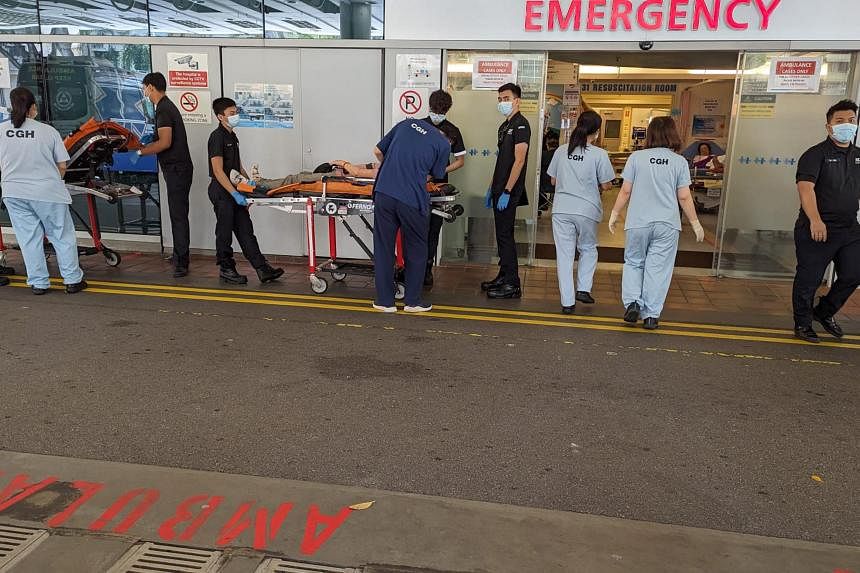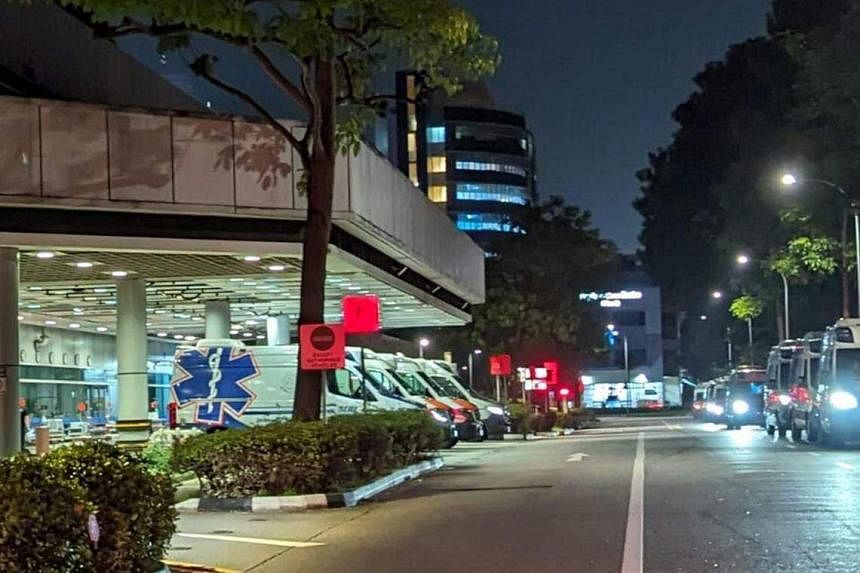Ambulances delayed as emergency departments struggle under high patient load

On Feb 19 at 10.30am, CGH staff were seen triaging patients on ambulance trolleys outside the Emergency Department. PHOTO: ST READER
Salma Khalik
Senior Health Correspondent
UPDATED
FEB 25, 2024, 05:32 AM
FacebookTelegram
SINGAPORE – On Jan 29 around 11pm, ambulances occupied all four of Changi General Hospital’s (CGH) ambulance bays, and another eight ambulances were lined up along the road outside. They were all waiting to complete the handover of patients.
The same time that night, CGH posted this on its Facebook page: “We are seeing a high number of patients at the CGH Emergency Department (ED). Priority of care will be given to patients with serious or life-threatening conditions, and waiting times will be longer.
“Save time and save lives by allowing our medical experts to focus on critical cases needing emergency attention.”
This was not the only time CGH has faced huge patient loads at its ED, nor is it the only hospital experiencing such a crunch.
The Singapore Civil Defence Force (SCDF) told The Sunday Times that it received about 700 calls a day for its emergency ambulance services between Jan 25 and 29, higher than the average 2023 figure of about 676 calls a day.
An even higher number was recorded in the first week of December 2023, when the 995 Emergency Medical Services (EMS) calls “surged to a high of nearly 750 calls a day”, the SCDF spokesman said.
When ambulances are delayed in discharging their patients at hospitals, fewer ambulances are available to answer emergency calls. So having 12 ambulances out of SCDF’s fleet of 92 stuck outside CGH’s ED is a matter of grave concern.
Catch up on the news that everyone’s talking about
Sign up
By signing up, you agree to our Privacy Policy and T&Cs.
Ambulances cannot leave hospitals until after the patients they had conveyed have been triaged by hospital staff – usually a senior nurse – and the handover is completed. Because some patients might not be lucid, paramedics need to tell hospital staff what they know, as this could help doctors in their diagnosis.
On Feb 19 at 10.30am, CGH staff were seen triaging patients on ambulance trolleys outside the ED. According to protocol, this should be done inside the ED.
That staff had to do this outside implies that the ED was full and had no immediate space for new arrivals who were not in critical condition.
The Ministry of Health (MOH) said about 40 per cent of ED attendances – including people who go to the hospital on their own and not by ambulance – do not need emergency care. These people should see a general practitioner, instead of going to a hospital ED.
CGH is one of two hospitals that consistently get the highest number of emergency cases in a day. The other is Tan Tock Seng Hospital. EDs are typically most crowded on Mondays, and can have 30 per cent to 40 per cent more patients than the average.
A CGH spokeswoman said: “Patient load at the CGH ED has been high and waiting times can be expected to be longer.”
When a hospital ED has a sudden influx of patients, staff there need to prioritise critical cases over serious cases, and serious cases over those that are of moderate severity.

Ambulances are parked outside Changi Hospital's emergency department PHOTO: ST READER
The CGH spokeswoman added: “Our ED staff are trying their best amid the constraints and workload, and will continue to prioritise emergency cases and attend to them first. Seriously ill patients continue to be attended to and cared for in a timely and optimal manner.”
She explained that attendances and ambulance cases at public hospital EDs are tracked across Singapore to coordinate where the ambulances take patients to, should there be a surge in cases.
“When there are extremely high patient loads, authorised ambulance diversions may take place,” she said. This means ambulances ferrying non-critical cases are told to take patients to the next nearest public hospital. How long such diversions last would vary according to the situation.
Replying to queries from ST, MOH said it has been “monitoring the situation” and is working with hospitals to address the “tight capacity”, which it says is exacerbated by Singapore’s ageing population.
“There is an increased number of elderly patients who are frail and have more complex conditions, thus requiring longer stays in the hospitals. This in turn translates to higher bed occupancy rates,” the MOH spokesman said.
“Aside from expanding the acute bed capacity, we are increasing the number of step-down and rehabilitative beds to facilitate more patients to be right-sited after they no longer require acute care.”
The latest data from the SCDF showed that in 2023, almost two in three medical-related EMS calls, which exclude calls for accidents and trauma cases, were for people aged 65 and older.
There were 113,000 calls to EMS in 2023 for those aged 65 and older – up from 109,000 in 2022 and 83,000 in 2021.
Given the sharp rise in the number of older people needing ambulance services in recent years, SCDF said it expects calls to EMS to continue trending upwards in the longer term “due to the rising demand from Singapore’s ageing population”.
SCDF has plans to cater to the expected increase in calls. But its spokesman said: “If EMS calls continue to climb, the public may experience delays in ambulance response.” Priority, he said, is given to life-threatening cases.
To make matters worse, SCDF gets about 50 non-emergency calls a day for conditions like toothache, slight burns and diarrhoea. Its website states: “Every non-emergency call could delay SCDF’s response to life-threatening emergencies, where every second counts.”
The MOH spokesman said: “We urge the public to seek medical treatment at an ED only for serious or life-threatening emergencies, such as sudden onset of chest pain, breathlessness, drowsiness or confusion, sudden onset of limb or body weakness.”
The National Healthcare Group, one of three public healthcare clusters, is piloting an Urgent Care Centre (UCC) in Woodlands.
The MOH said: “On top of the usual conditions that primary care physicians manage, the UCC can also perform simple blood tests, X-rays, plaster casts for minor fractures, and intravenous fluids for short periods with observation.”
The National University Hospital also runs a paediatric UCC in Bukit Panjang.
The ministry said it is also opening more community hospitals and nursing homes and expanding transitional care facilities and Mobile Inpatient Care at Home where patients can receive acute care at home, instead of needing to go to hospital, to reduce the hospital bed crunch.
